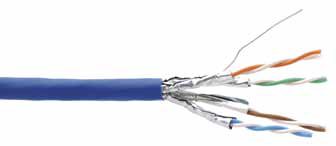In the analog video world, type and quality of twisted pair cabling was never a major concern. Installers could visit their local hardware store and pick up a spool of any CAT 5E cable. Sure, the need for low skew twisted pair cabling was always there, but for the majority of AV installs (which tend to be under 300 feet), even that was not always necessary. The problem is that AV integrators got used to the connotation of “I’ll just run CAT 5.”
Kramer’s BC-DGKat623 Four−Pair STP (Shielded Twisted Pair) Data CableWe now live in a digital world; traditional CAT 5 has become inadequate. With installers using twisted pair solutions now more than ever, it is vital that the correct cabling is chosen. Not all twisted pair cables are created equally. There are many factors in the specifications of twisted pair cable that can dramatically affect the quality and distance capability of a digital video signal. Some of these factors include shielding, center conductor type, and connector type.
Here are a few important factors to take into consideration when deciding which twisted pair solution to use for a digital AV signal.
Types of Cable
Twisted pair cable can have either solid or stranded conductors. Solid cables typically come in bulk spools and are intended for long runs in computer networks. They are less flexible than stranded cables, but also have less attenuation and can be run longer distances than stranded cables. Computer networks might have cable runs exceeding 300 feet. To run that distance, network installers will run solid cable throughout the building and connect the ends to punch down blocks on the rear of a wall plate.
Stranded cables are found in patch cables and are intended to connect computers to the front of the wall plate using RJ 45 connectors. They are more flexible, because they are the cables that get connected and disconnected constantly.
In a digital AV application, conductor type should be the first major consideration. In these applications, solid conductor cables should be used. They allow for higher bandwidth, less attenuation, and longer distances.
Two Types of RJ-45 Connectors
There are two types of RJ 45 connectors: insulation displacement RJ 45 connectors (designed to work with solid conductor cables), and insulation piercing RJ 45 connectors (designed to work with stranded conductor cables). The difference in these connectors lies within the teeth that puncture the eight wires inside the cable. The vast majority of RJ 45 connectors on the market today are insulation piercing. If insulation piercing connectors are used on solid core cable, the connection will not be stable, as the teeth try to but are unable to penetrate the solid center conductor. The teeth then end up sliding off the side of the solid core and do not make stable contact.
This is why the connector type is important. You wouldn’t put road-racing tires on an off-road truck, would you?
Three Types of Shielding
The final major factor in deciding which cable to use for a digital AV signal is shielding. Shielding protects the signal from two main types of interference, internal crosstalk and external interference. Internal crosstalk is the interference between different pairs inside one cable. External interference is any interference that comes from outside the cable. It can be caused by many things, including bundling cables together and running cables over lighting fixtures. Internal crosstalk is the most detrimental thing to digital video signals since signals cannot be recovered after experiencing crosstalk. This type of interference impedes the twisted pair receivers’ ability to understand the signal.
The first and most common type of shielding is screened—unshielded twisted pair (S/ UTP). It only has an overall shield and is great for protecting the signal from external interference. It does not protect against any internal crosstalk.
The next type of shielding is shielded twisted pair (STP). It has four individual shields, one for each pair inside the cable. STP is great for protecting the signal from internal crosstalk, but does not have an overall shield to protect against external interference.
The third type of shielding is screened— shielded twisted pair (S/STP). It has four individual shields, one for each pair and an overall shield. S/STP is the best cable to protect from any type of interference.
We all know that digital AV signals have distance limitations. The best way to overcome these limitations is to send the signals using a twisted pair solution. When considering which cable and connectors to use, there are multiple factors to take into consideration. Hopefully the information presented here will help you in your next project.
Brian Morris, CTS, is the sales support engineer at Kramer Electronics US.
info
Kramer
kramerus.com










